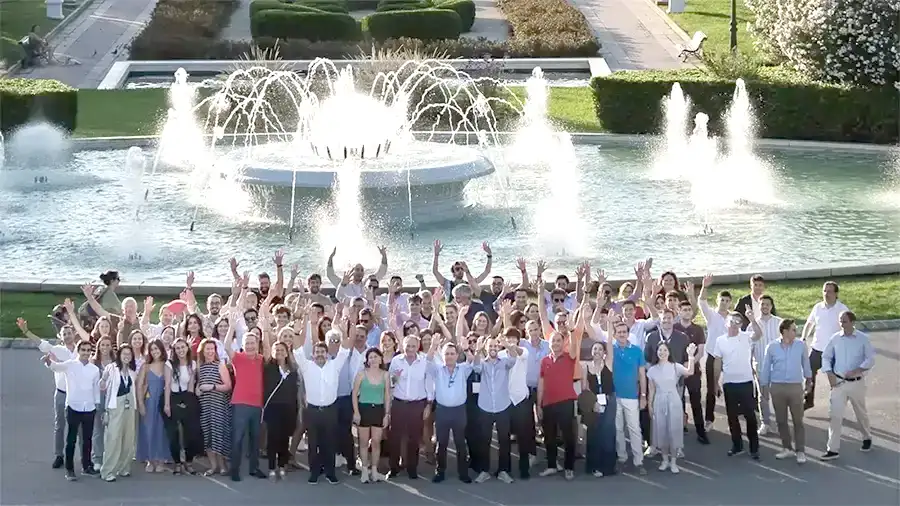From Voice to Business

By Dayana Ribas
Bridging the AI Divide: Transforming Research into Real-World Solutions
Artificial intelligence (AI) has permeated countless aspects of modern life, yet a crucial gap remains between academic advancements and industrial adoption. This divide hinders the transformative potential of AI technologies, particularly in speech and language applications.

According to the Iberspeech Roundtable, which I led alongside Arantza del Pozo (Head of the speech and natural language technology at Vicomtech), Andreas Stolcke (AI scientist and Vice President at Uniphore), and Chelus Gonzalez-de-Suso (Technology/Biometrics Lead at Veridas).
In the tech sector, the following discussion will address key challenges, focusing on adaptability, targeted problem-solving, and strong collaborative relationships—topics that generated insightful discussions during the roundtable held within the framework of the Iberspeech workshop. Iberspeech serves as a key forum for discussing advances in research on speech and language technologies for Iberian languages, bringing together experts from both industry and academia to bridge the gap between research and real-world applications.
Why Bridging Academic and Industrial AI Gaps Could Define the Future
Standing at the intersection of academia and industry, I emphasize the importance of technology transfer. “We are always, when writing a paper, thinking about how we are going to apply our research,” I note. However, this application requires overcoming numerous hurdles, particularly for small and medium enterprises (SMEs) that lack resources to stay abreast of technological advancements.
Organizations such as Vicomtech, an applied research center specializing in digital technologies related to Visual Computing, Interaction, and Artificial Intelligence, are primarily dedicated to addressing the applied research, development, and innovation needs of businesses and institutions. Their mission is to equip these entities with the necessary tools to tackle emerging financial and social challenges, ultimately enhancing their competitiveness in the global marketplace. “Many companies come to us with specific needs unmet by general market technologies,” explains Arantza del Pozo. By customizing solutions to niche requirements, applied research centers help SMEs stay competitive while fostering innovation in untapped markets. BTS exemplifies this approach by collaborating with researchers to develop AI-driven solutions for voice enhancement and fraud detection, unlocking growth and elevating service offerings by leveraging voice data’s full potential.
Case Study: AI in Customer Service
The transformative impact of AI on customer services exemplifies how technology can revolutionize traditional business operations. Andreas Stolcke provided an insightful case study into how AI is reshaping this industry.
Customer service has long been a labor-intensive domain, requiring extensive human involvement in handling inquiries, resolving issues, and maintaining customer satisfaction. Stolcke explains how AI now plays a pivotal role in this space: “Instead of talking to a human, you talk to a bot. But even when humans are involved, speech understanding systems assist, making agents more productive.” This dual approach of automating simpler tasks while increasing human interaction streamlines services and enhances the quality of service.
The financial advantages of AI integration are significant. By automating tasks such as real-time data retrieval, answering customer inquiries, and summarizing calls, AI tools alleviate the workload on customer service agents, leading to increased efficiency and cost savings. This makes agents more effective, allowing businesses to achieve more with fewer resources, which as a result reduces operational costs. Stolcke highlights that companies benefit from cost savings not only in labor but also in infrastructure, as AI systems efficiently manage high volumes of inquiries, reducing the need for additional resources. However, the benefits go beyond cost benefits. Adopting AI is crucial to stay competitive, as Stolcke warns about the case of inaction: “You realize how much money you save by replacing outdated systems with AI. If you don’t act, your competitors will.” In a fast-paced industry, failing to innovate and adapt can lead to falling behind.
Building Adaptable and Business Tailored AI-Driven Solutions
The key to successful AI deployment is adaptability. Clients often require solutions tailored to their specific use cases. “We usually develop proofs of concept,” says del Pozo. These prototypes provide a cost-effective way to determine the feasibility of the project before committing to product development. This approach also ensures technologies align closely to client needs. Adaptability is critical since each client requires unique solutions, and designing adaptable technologies ensures long-term scalability and relevance.
Identity Verification: The Shift of AI-Driven Security
Veridas, specializing in digital identity verification and biometric authentication solutions with the mission to guarantee individuals’ right to use their real identities in both digital and physical realms. Striving for a passwordless and keyless future, they began with a simple concept: preventing fraud. Their journey showcases their nature of innovation. “Initially, we combined AI with security technologies to create banknote detection systems. Over time, we expanded to solutions for remote identity verification and other industries,” explains Gonzalez-de-Suso.
These successes demonstrate the importance of embracing adaptability. By listening to client needs and responding to emerging challenges like deepfake detection, companies remain at the forefront of technological innovation.
Looking Ahead: Challenges, and Opportunities for Researchers
Despite these advancements, significant challenges persist. Data quality and availability often hinder progress, as real-world datasets tend to be messy and require extensive preprocessing. Additionally, legal and privacy concerns add complexity, particularly in Europe, where regulations such as the EU General Data Protection Regulation (GDPR) shape operational practices. However, these challenges also present opportunities. Companies that prioritize security and transparency can both build trust with clients and also gain a competitive edge.
As AI continues to evolve, experts emphasize the need to focus on impactful and underexplored problems. “Don’t just aim for incremental improvements,” advises Stolcke. “Ask yourself: What is the problem others haven’t solved yet?”
Innovation and Adaptability to Drive Evolution
The intersection of voice technology and business presents unparalleled opportunities for innovation and growth. The session concluded by emphasizing that in well-established industries, such as telecommunications, the core business has traditionally been built around robust and static voice technologies. These industries have long relied on research findings to enhance their core operations with innovative advancements.
However, companies inevitably reach a critical juncture where they must choose to innovate or risk obsolescence. This is precisely the approach BTS has adopted by developing an in-house technology lab that serves as a bridge between research findings and business innovation, driving the evolution of its operations.
Through the panel discussion, we’ve explored how voice technologies are transforming customer interaction, enhancing operational efficiencies, and addressing specialized needs like fraud detection, identity management, and accessibility. Companies like Vicomtech, Uniphore, and Veridas exemplify the various applications of speech and language technologies, showcasing adaptability as the foundation for success in this evolving industry. As Stolcke highlighted, “The majority of uses where we apply technology are about making human labor more efficient, reducing cognitive load, and automating processes incrementally.” This approach not only saves costs but also enhances service quality. Similarly, the adaptability of voice technology is essential, as noted by del Pozo: “Designing a product that can adapt to the needs of different clients is very important,” enabling businesses to cater to unique and evolving requirements.
Monetization strategies revolve around leveraging AI to automate labor-intensive processes, offering tailored solutions for the digital markets, and creating scalable, secure products that address customer needs. As Gonzalez-de-Suso shared, convincing clients often requires showcasing measurable benefits: “You are saving 10% of time in addressing specific problems because you can verify identities seamlessly.” This highlights the importance of demonstrating tangible value.
Ultimately, the voice business is not just about innovation but also about trust and adaptability. By collaborating with academia and industry partners, businesses can stay ahead of technological trends while ensuring data privacy and regulatory compliance. Whether by reducing costs, increasing efficiency, or enhancing customer experiences, the potential for growth and monetization in voice technology is vast provided businesses prioritize quality, flexibility, and a customer-centric approach.
ABOUT THE AUTHOR







